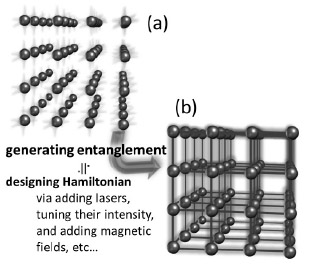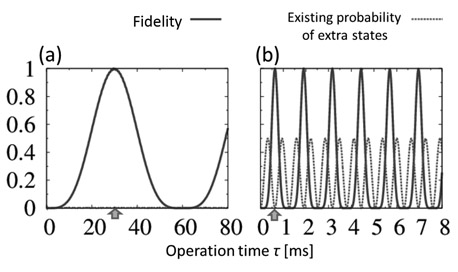Cluster State Generation for Ultracold Atoms in an Optical Lattice
An optical lattice is the artificial crystal created by the laser interference, and a million of ultracold atoms can be trapped in each lattice site. Using (pseudo-) spin states of each atom as a qubit, we might realize million-bit-size quantum computer. For this final goal, it is required to establish the high-fidelity entanglement generation. In this study, we theoretically propose an entanglement generation implemented with a combination of some simple experimental techniques, such as, irradiating lasers and tuning their intensities [1]. Precise numerical simulation confirms that our method can create a high-fidelity multipartite entanglement, that is, the cluster state, in a short operation time with scalability.
In what follows, we detail a part of our method. Here, we use a hyperfine state of a fermion as a qubit. By utilizing quantum phase transition of fermions, such as, the band insulating transition, we can prepare the required initial state in which a single atom occupies each lattice site. However, in this state, there is no entanglement between atomic spins at different sites (Fig. 1(a)). By performing some operations on this state, e.g., adding laser lights, we can design the Hamiltonian of the atoms, which allows us to control the spin-spin correlation and then yields spin entanglement (Fig. 1(b)). However, the Hamiltonian describing the atomic quantum states includes the extra quantum states, such as, orbital states and multiple site occupancies, in addition to the (qubit) spin states. Existence of the extra states is the source of the error that greatly decreases fidelity of entanglement generation. The previous proposals avoid such an error by creating entanglement slowly (Fig. 2(a)), which is, however, a weak point for practical implementations. We thus propose to utilize a resonant inter-orbital transition, which can be induced by only modulating an optical lattice potential with an additional laser. The resonant tunneling allows us to fast create entanglement, while it also causes an error due to the appearance of an excited orbital state (Fig. 2(b)). We clarify the mechanism of this error and further propose to synchronize an oscillation caused by the error with that of the entanglement generation [dotted and solid lines in Fig. 2(b), respectively]. We can thus create a very high-fidelity entangled cluster state within a short time.
- [1]
- K. Inaba, et al, Phys. Rev. Lett. 112 (2014) 110501.
 |
 |
|
|